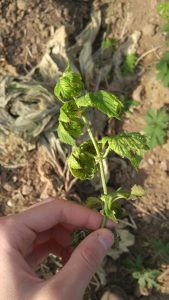Hello everyone, my name is Allyson Wentworth and I am a junior studying agricultural sciences and viticulture and enology at Cornell University. My interest in agriculture stemmed from the ten years I spent in 4-H training dogs. I was exposed to the agricultural industry and decided that it was the field I belonged in. After deciding that agriculture was the path for me, and arriving at Cornell, I quickly learned that I wanted to focus on integrated pest management (IPM). During September of 2017, I managed a post-doc student’s research on phylloxera, a common grapevine pest that devastates vineyards by feeding on the rootstock. The goal of this research is to discover what signaling causes the phylloxera to feed on some varieties of rootstock, and not others, and whether there is a plant out there with similar signals that can detract the phylloxera from the rootstock. After working with this research for a month, I decided that I wanted my summer internship to focus on IPM.
On May 25th, I arrived in Toppenish, Washington where I began work at Perrault Farms, Inc. located on the Yakima Reservation, one of the largest hop growing regions in the world. Perrault Farms owns and farms over 1500 acres of commercial and organic hops and 30 acres of organic blueberries. Perrault Farms works alongside Select Botanicals Group, Yakima-Chief HopUnion, and Hop Breeding Company to develop new hop varieties and further their sustainability. I am here working as an IPM scout, searching the fields for pests and disease.
I will be spending the summer scouting Citra and Mosaic hop fields, along with a few experimental varieties and a small acreage of Ekuanot and Palisade. All of these varieties were developed by either Select Botanicals Group (SBG) or the Hop Breeding Company (HBC). One of the more well-known varieties that was discovered by Perrault Farms was Simcoe. Fun Fact: Simcoe was one of the hops chosen to brew the Windsor Knot, which was the beer served at Harry and Meghan Markle’s wedding in May.
Citra Fields Week 1
My day begins by arriving to the farm at 5:00 AM, just before the sunrises. There is a lot of work that needs to get done so the earlier we arrive, the earlier we finish scouting our assigned fields. This is also nice because the mornings here are cold, so we don’t have to work outside during the heat of the day.
5:00 AM Sunrises
We load up our ATV’s with what we will need for scouting and head out. Each weekday is assigned about 4 to 6 different fields that need to be completed with different scouting density levels. Scouting density levels are determined by the degree of pest or disease thought to be present in a field. A level 1 density is scouting one geographical point, which is described as a pole-to-pole section of 15 hops, every 15 rows. Level 2 is 2 points every 10 rows and level 3 is 2 points every 5 rows.

Protection from the Sun and Dust
The first week we began scouting for powdery mildew and downey mildew. Powdery mildew appears near the hill (base) of the bine and will spread upwards. Bines are susceptible when temperatures are high and moisture is present in the hill. It appears as a fuzzy, white, misshapen blotch on the leaves and if not treated properly, can devastate the entire crop. Downey mildew appears in moist conditions. Therefore, it is typically seen after a heavy rainfall. It’s characteristic traits are short, stunted vines growing near or around the hill, with downturned yellow-colored leaves and black spores on the underside of the leaves. A bine infected with downey mildew will only grow to about half it’s typical height and therefore yields will be significantly lower.
My project for the season is to measure nutrient levels within the vegetative growth of the bine and determine what nutrients the hops are deficient or overly-sufficient in and how to resolve the issue. Old and new leaf samples of various fields are collected to be tested. The reason for collecting both old and new leaf samples is to see if the nutrients from the old samples have been are mobile, and therefore present in the new leaves. The leaves are placed in a hydraulic press which squeezes sap out and into a small sample cup. I will then take these samples and run sap analysis which involves the use of six different sensors. These sensors measure the levels of nitrate, potassium, calcium, sodium, pH, and water conductivity. Thus far, there have not been any determinations made on what nutrients need to be applied to fields but I am hoping to help make these decisions starting next week!

Meters Used to Measure Nutrients
Hydraulic Press
Sap Samples
We have also begun scouting for pests and beneficials, however, since it is early in the season, and the weather has been rather mild, there hasn’t been too many sightings of either. Next week should begin to pick up with pest pressures and I will be reporting back with more information and pictures on that!
Hop Fields and Mount Adams





